Back to
Contents - Next
July 30 - Copenhagen
Click a picture to see a
larger view.

The Copenhagen Opera House
Copenhagen is at once old-world European and
familiar. For an American, it is easy to navigate a city where both English is
spoken and the drivers are staying on the right side of the road.
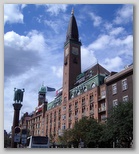 Although you might look in
the same direction as in the States before crossing the road, you may be winged
by something you do not usually consider: the bicycle. Copenhagen is filled with bikes and the biker
is accommodated by a network of bike lanes that take equal status with other
vehicular traffic. The bike’s popularity is enhanced by a city government that
stations groups of bikes for public use around the city. Just drop a few coins
to unlock and use.
Although you might look in
the same direction as in the States before crossing the road, you may be winged
by something you do not usually consider: the bicycle. Copenhagen is filled with bikes and the biker
is accommodated by a network of bike lanes that take equal status with other
vehicular traffic. The bike’s popularity is enhanced by a city government that
stations groups of bikes for public use around the city. Just drop a few coins
to unlock and use.
Part of Copenhagen is a
Nordic mix of Venice and Amsterdam. The sea is its gateway as in Venice and there are canals 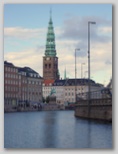 through the city as in Amsterdam. Part of Copenhagen is an old
medieval city with a large moat with fort bastions jutting out into it.
through the city as in Amsterdam. Part of Copenhagen is an old
medieval city with a large moat with fort bastions jutting out into it.
The city is compact and, even without a bike, easy to
navigate by foot. The cruise line arranged our flight and hotel and they put us
up for a couple of nights in the Radisson SAS Scandinavian Hotel which was a
fifteen minute walk to city center. The hotel, at 26 stories, was by far the
tallest building we saw and it was placed a respectable distance across a 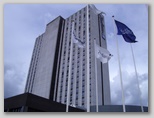 river from the town’s
center.
river from the town’s
center.
The guide on the motor coach that brought us from the
airport to the hotel mentioned that the highway in front of the hotel would be
closed to vehicular traffic that day due to a triathlon race. It turned out
that we were in Copenhagen
the day of the 2007 International Triathlon Union’s European Cup
competition. As we strolled across the
river we caught sight of the racers below us during the swimming part of the
competition. They left the water at that point, shed their wet suits and hopped
on bikes for the final leg of the competition.
It was happenstance that we witnessed the competition. We
were headed to Tivoli
Gardens. How can one go
to Copenhagen and not see Tivoli? Opened in 1843, it is the grandfather
of amusements parks. Tivoli
is the inspiration for all modern-day theme parks and when you enter from the
northeast corner as we did, you may first think you are in just another theme
park. It is in this corner of the park that house all the gut-wrenching roller
coasters, free fall towers, and other devises of mass disruption.
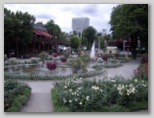
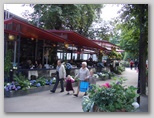
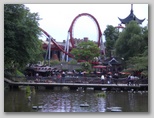 However,
walk just beyond and you are quickly in the “Garden” part of Tivoli Gardens.
Tivoli has
acres of lush plantings of various flowers and flowering plants and shrubs,
long pebbled walks beneath shade trees, and restaurants, lots of restaurants,
over twenty all together. We ate lunch at one of these garden restaurants
sampling Danish fare. A note is in order here. The most popular food in Copenhagen is not their
native dining. In fact, it is hard to find what is considered native dining.
Fish, boiled potatoes and pork is not the fare attractive to most diners,
However,
walk just beyond and you are quickly in the “Garden” part of Tivoli Gardens.
Tivoli has
acres of lush plantings of various flowers and flowering plants and shrubs,
long pebbled walks beneath shade trees, and restaurants, lots of restaurants,
over twenty all together. We ate lunch at one of these garden restaurants
sampling Danish fare. A note is in order here. The most popular food in Copenhagen is not their
native dining. In fact, it is hard to find what is considered native dining.
Fish, boiled potatoes and pork is not the fare attractive to most diners, 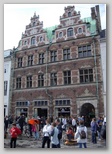 including the Danes
themselves. The city boasts a variety of ethnic dining.
including the Danes
themselves. The city boasts a variety of ethnic dining.
Shoppers, be prepared for more conservative business hours.
Shops are open only until 5 PM each day and do not open at all on Sundays
(except for the first Sunday of each month). Which leaves you with the question
of what to do in the land of the midnight sun from 5 PM on?
One option was a cruise of the canals. There are low, wide
boats made for the low bridges of Copenhagen.
We picked up one and took in a view by water. There you can see the new Opera
house positioned out in the bay, a home-made submarine in which the builder
lives, and the little mermaid (no, not Disney’s, Hans Christian Anderson’s).
The bronze statue is turned towards a park on the shore; so unfortunately, you
see only her backside from the water.
Along the canal, we also saw the palace of the queen. The
Scandinavian countries have an interesting relationship with their royalty.
They are quite popular, especially in Norway, and have more of a common  touch. This is in stark
contrast to what we would learn about the Russian royalty later in the trip.
touch. This is in stark
contrast to what we would learn about the Russian royalty later in the trip.
Denmark
once ruled Sweden
as a part of its territory. Sweden
became an independent country in 1660, but there are signs of the former union,
such as a church spire of two serpents representing the two countries.
Copenhagen is a fine city for the start of a trip around the
Baltic and as a destination in itself.
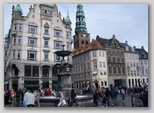

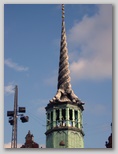
 Although you might look in
the same direction as in the States before crossing the road, you may be winged
by something you do not usually consider: the bicycle.
Although you might look in
the same direction as in the States before crossing the road, you may be winged
by something you do not usually consider: the bicycle.  through the city as in
through the city as in  river from the town’s
center.
river from the town’s
center.

 However,
walk just beyond and you are quickly in the “Garden” part of
However,
walk just beyond and you are quickly in the “Garden” part of  including the Danes
themselves. The city boasts a variety of ethnic dining.
including the Danes
themselves. The city boasts a variety of ethnic dining. touch. This is in stark
contrast to what we would learn about the Russian royalty later in the trip.
touch. This is in stark
contrast to what we would learn about the Russian royalty later in the trip.


